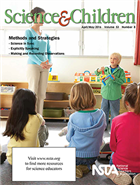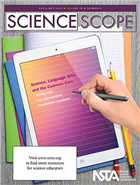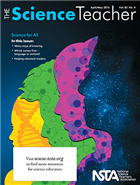Ideas and information from NSTA's April/May K-12 journals
By Mary Bigelow
Posted on 2016-04-27
This month, all three K-12 journals include the article Addressing Student Diversity and Equity. Another must-read article for all science teachers!
 Science and Children- Methods and Strategies
Science and Children- Methods and Strategies
Think about how the “methods and strategies” described the featured articles can be applied to other lessons and other grade levels. Most of the articles include examples of student work and a detailed chart connecting the lesson to the NGSS.
- Many of us use “thumbs-up” for students to indicate their understanding of a concept. Meta-Sticks takes this further with suggestions for students to share their beliefs and describe the source of their understanding.
- We read a lot about integrating science and language arts, which can be easier said than done. Science in Sync offers concrete suggestions for connecting reading with NGSS scientific practices, including a lesson template and a chart with corresponding scientific practices, reading skills, science activities, and examples of related texts. How About Teaching Literacy With Science? answer its own question with suggestions and a sample lesson for using student whiteboards to generate, share, synthesize, and build on ideas.
- Promote scientific language and communications with the routines described in Explicitly Speaking: awareness, modeling, supported practice, and integration.
- Making and Recording Observations is the backbone of science investigations. Here are strategies and rubrics for helping students to make and record observations that are complete, accurate, clear, objective, and labeled.
- If To Kit or Not to Kit? is the question, the article has suggestions for assessing the extent to which kits are (or are not) aligned with NGSS.
- The two investigations in Teaching Through Trade Books: Roly-Poly Pill Bugs capitalize on children’s fascination with these arthropods.
- The Early Years: Encouraging Curiosity has suggestions for encourage young children to ask questions and how to involve families through a “Question of the Day.”
- Formative Assessment Probes: Talk Moves show how to turn a probe into rich, student-focused classroom discussions.
For more on the content that provides a context for these projects and strategies see the SciLinks topics Animal Adaptations, Arthropods, Buoyancy, Ecosystems, Fossils, Weathering.
Continue for Science Scope and The Science Teacher.
 Science Scope – Science, Language Arts, and the Common Core
Science Scope – Science, Language Arts, and the Common Core
The featured articles in this issue have many suggestions for helping students write arguments, informational and explanatory text, and narratives. Perhaps our colleagues in Language Arts would be interested, too. And the editor makes a good case for also incorporating creative writing in science, too, to tap into student interests. Most of the lessons include a detailed chart connecting the lesson to the NGSS.
- The authors of Using Apps to Integrate Writing Into Science Education share examples of free or low-cost apps to help students organize their writing, annotate text, create and use a science notebook, collaborate, and incorporate multimedia into their communications.
- Making Science Real: Supporting English Learners in Argumentation and Exploration Through Authentic Tasks goes beyond simple collections of strategies to using real-life investigations to integrate skills. The article includes a description of the tasks, a rubric, and samples of student work.
- Do your students struggle with the language of science? The author of Personalized Vocabulary Learning in the Middle School Classroom describes the “In a Word, In a Symbol” strategy (with examples) that has been effective in his classroom.
- In the classroom, students read a different levels. Light, Color, Vision, Optics! A Text Set for Grades 6–8 shows how to create a sequence of texts on a topic that provide essential information, scaffolding, and elaboration.
- Naming the Solar System: Implementation of Vocabulary Strategies to Improve Scientific Literacy integrates a Frayer model and word walls into an interactive experience to help students with specialized vocabulary. Examples of student work are provided.
- Simple investigations can be the context in which students have opportunities for speaking, reading, writing, and listening as described in Tried and True: Problem-Based, Enhanced–Language Learning With Pendulums. The 5E lesson was designed for English-language learners but would be appropriate for all.
- Teacher’s Toolkit: Explanations Across the Curricula: Integrating Common Core State Standards in Literacy With the National Science Education Standards includes examples of student work that show how the Claim-Evidence-Reasoning explanation can be used across the curriculum, promoting literacy in science, language arts, and social studies.
For more on the content that provides a context for these projects and strategies see the SciLinks topics Chemical Reactions, Earthquakes, Pendulums, Plate Tectonics, Properties of Light, Solar System, Temperature, Visible Light, Water Quality.
 The Science Teacher – Science for All
The Science Teacher – Science for All
The annual “Science for All” issue reaches out to all teachers with ideas and strategies to help students with various backgrounds, skills, and interests achieve in science. Most of the lessons in TST include a detailed chart connecting the lesson to the NGSS.
- Which Comes First—Language or Content? describes the integration of two approaches to supporting English learners in the classroom: the 5E Learning Cycle and the Sheltered Instruction Observation Protocol (SIOP).
- The authors of Many Ways of Knowing share a lesson on climate change in which students investigated collaborations between indigenous knowledge systems and Western science.
- We often think of Family Science Night in the context of elementary schools, but the authors share their experiences in planning and hosting an event for immigrant families.
- If there are students in your class who struggle with traditional science text or try to avoid reading, Helping Reluctant Readers provides strategies for modifying or revising text to make it more accessible. Examples are provided.
- Critical Response Protocol has examples of a protocol that includes five prompts for enhancing student understanding, discussion, and critical thinking, using nanotechnology as the context.
- Science 2.0: Mastering Scientific Practices With Technology, Part 3 describes technology tools for the practices of Engaging in Argument from Evidence and Obtaining, Evaluating, and Communicating Information.
- The Green Room: When Lead Flows From the Tap has suggestions for real-life and timely investigations about lead poisoning.
- Health Wise: Helping Students Cope With Dyslexia offers suggestions and resources to meet the needs of students with this learning disorder.
For more on the content that provides a context for these projects and strategies see the SciLinks topics Climate Change, Land Use, Landfills, Migration of Birds, Nanotechnology, Pollution.
Disclaimer: The views expressed in this blog post are those of the author(s) and do not necessarily reflect the official position of the National Science Teaching Association (NSTA).


